Electrically switchable objective lenses

Photograph of several metalenses on a glass substrate, illuminated from the top with white light.
Photo: 4th Physics Institute
Latest generation smartphones feature often more than 4 microlenses. The reason for this is the desire to take snapshots of a quality that is comparable with those of much more expensive cameras. Such cameras often possess zoom lenses which allow for wide-angle as well as for telephoto images.
Common smartphone allow such zooming electronically, by magnifying parts of an image using two fingers on your display. However, the maximum magnification of this electronic zoom function is limited by the coarse pixel resolution, as the image is magnified in the display only. To overcome this problem, the smartphone companies used multiple lenses with different focal lengths. They allow for different fields of view and magnifications, just like the older SLR (single lens reflex) cameras with different objective lenses.
Ideally one would like to have just a single lens on the back of the smartphone, one that can zoom just like a large camera objective lens. To realize this would require to change the focal length of the lens. 28 mm focal length give a wide angle and a small magnification, 50 mm focal length have a similar field of view as the human eye, and 125-200 mm work like a telephoto lens with large magnification and a small field of viel. Sports photographers often use huge telelphoto lenses with focal lengths of 500 mm and more.
If one wants to realize such a zoom system in a rather flat smartphone, one would require a lens whose focal length can be purely electronically tuned, without a complex mechanism that is often prone to get stuck.
A team of physicists and chemists at University of Stuttgart have chosen an entirely new approach to solve this issue: In the latest issue of the journal Nature Communications they present an electrically switchable metaobjective lens that can change its focal length by the push of a button. To realize their system, they combine several metasurfaces consisting of nanoantennas that are smaller than 1 micrometer in size. These nanoantennas are made from a conductive polymer that changes its optical properties when voltages of ±1 V are applied. The switching times are less than a second, and the focal length of the metalens is changed. The polymer is changing its properties from metallic (reflective) to dielectric (transparent) and back upon applying the right voltage.
The objective lens from Stuttgart is a combination of two metasurfaces which can be switched independently of each other. Hence, several combinations are possible, resulting in a variety of focal lengths.
Up to now the objective lens works in the near infrared wavelength range, says Dr. Julian Karst, who led the research. Also, the efficiency of the metalenses is not yet comparable to glass lenses. Hence, part of the light is not being focused. Prof. Harald Giessen, who is heading the group of researchers, hopes that Chemists and Material Scientists will come up with improved materials. Especially polymers with higher charge carrier densities are required, such that the lenses will also work in the visible spectrum. Further improvements would also reduce the switching times, such that frequencies of 100 Hz or even kHz might be reached.
Julian Karst, Yohan Lee, Moritz Floess, Monika Ubl, Sabine Ludwigs, Mario Hentschel, and Harald Giessen: Electro-active metaobjective from metalenses-on-demand, Nature Communications 13, 7183 (2022). https://doi.org/10.1038/s41467-022-34494-0
https://www.uni-stuttgart.de/en/university/news/all/Electrically-switchable-objective-lenses/
Media Contact
All latest news from the category: Physics and Astronomy
This area deals with the fundamental laws and building blocks of nature and how they interact, the properties and the behavior of matter, and research into space and time and their structures.
innovations-report provides in-depth reports and articles on subjects such as astrophysics, laser technologies, nuclear, quantum, particle and solid-state physics, nanotechnologies, planetary research and findings (Mars, Venus) and developments related to the Hubble Telescope.
Newest articles

Molecular gardening: New enzymes discovered for protein modification pruning
How deubiquitinases USP53 and USP54 cleave long polyubiquitin chains and how the former is linked to liver disease in children. Deubiquitinases (DUBs) are enzymes used by cells to trim protein…

Machine learning accelerates catalyst discovery
Conceptual blueprint to analyze experimental catalyst data. Machine learning (ML) models have recently become popular in the field of heterogeneous catalyst design. The inherent complexity of the interactions between catalyst…

More efficient car designs with AI
8,000 open source models for sustainable mobility. Designing new cars is expensive and time consuming. As a result, manufacturers tend to make only minor changes from one model generation to…



